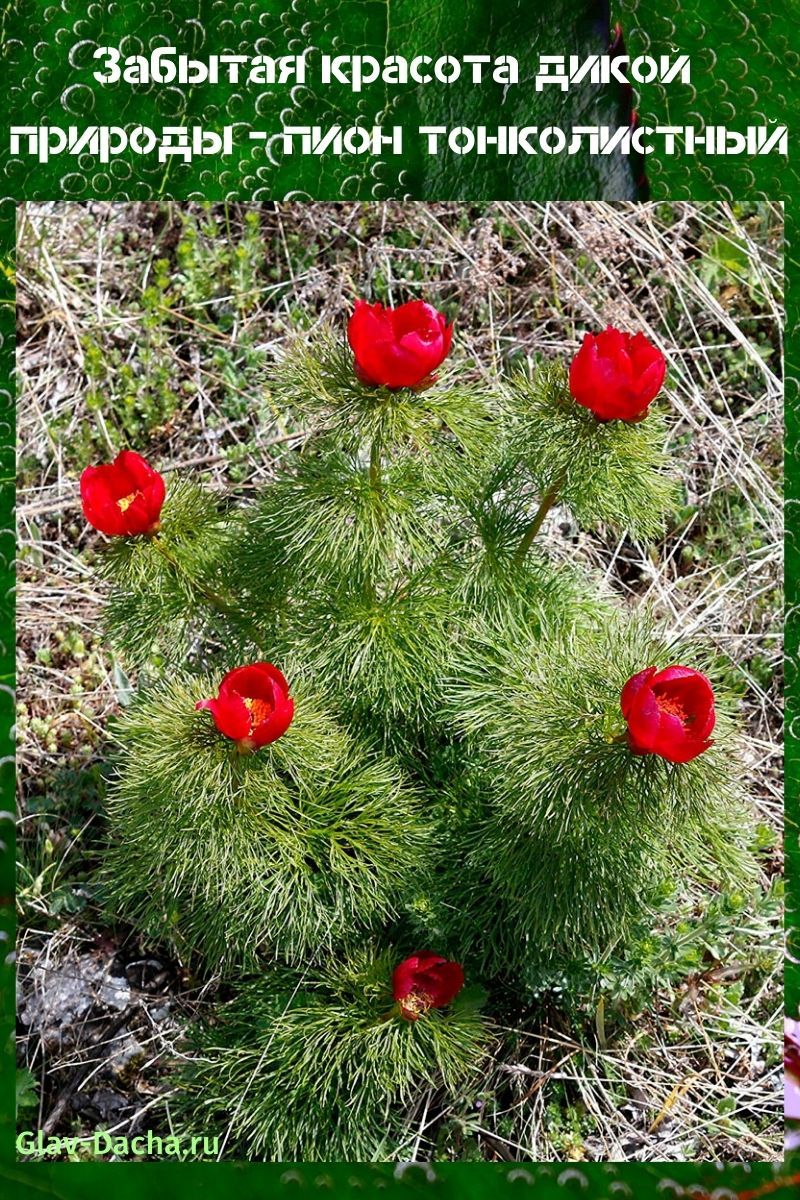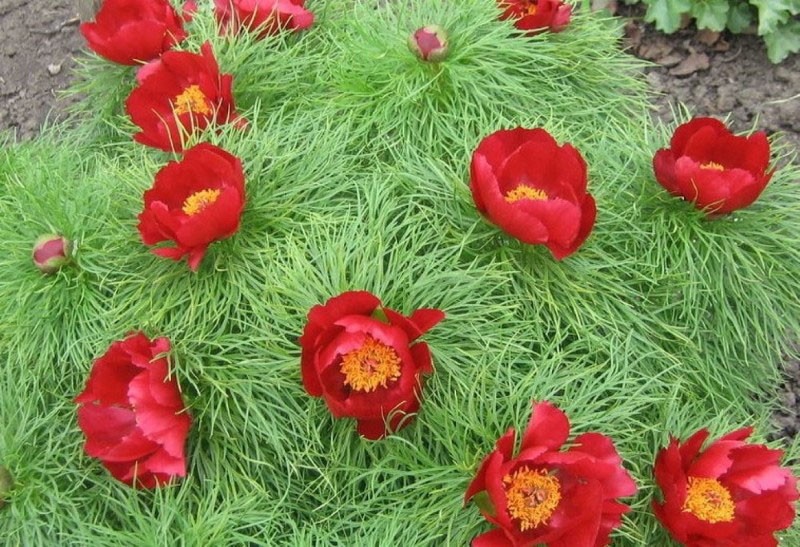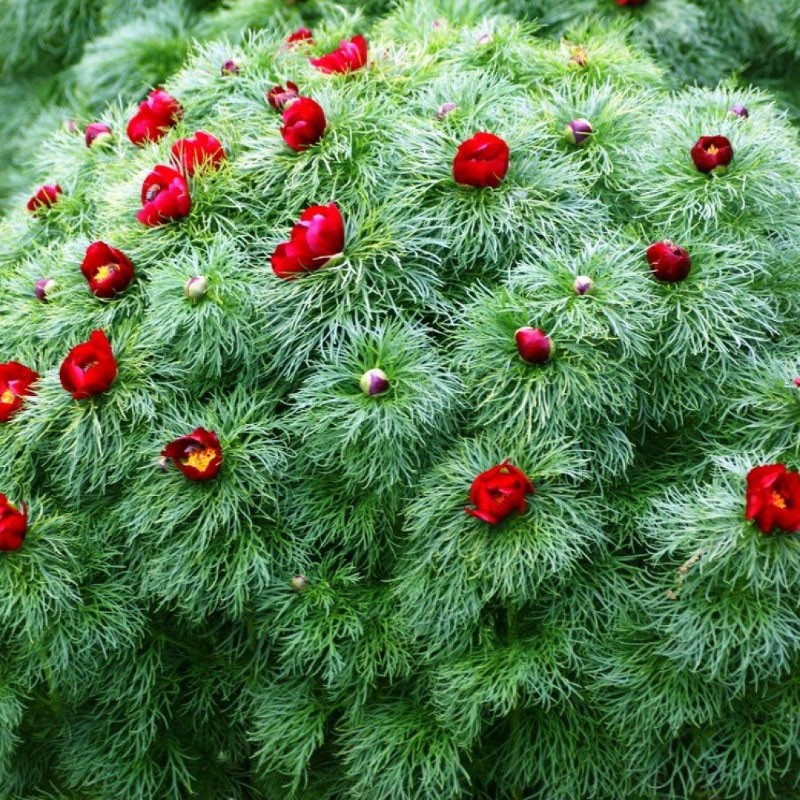Forgotten beauty of the wild - fine-leaved peony
 Its huge bloody buds with their open bowls look more like poppies, and the fluffy openwork foliage resembles chamomile or dill leaves. The thin-leaved peony is beautiful precisely for its special, natural, charm, and is a rare plant under the protection of the law. And even if it is inferior to varietal peonies in the originality of the structure and color of flowers, but because of this it does not become less decorative. Connoisseurs of classical cultures will appreciate the unpretentious nature, and fluffy foliage, and graceful buds.
Its huge bloody buds with their open bowls look more like poppies, and the fluffy openwork foliage resembles chamomile or dill leaves. The thin-leaved peony is beautiful precisely for its special, natural, charm, and is a rare plant under the protection of the law. And even if it is inferior to varietal peonies in the originality of the structure and color of flowers, but because of this it does not become less decorative. Connoisseurs of classical cultures will appreciate the unpretentious nature, and fluffy foliage, and graceful buds.
Botanical characteristics of the fine-leaved peony

 Peony leaf plates are thin, in the form of long needles, pinnately dissected 2 or 3 times. And there are so many of these needles that the whole bush looks fluffy. The color did not disappoint either - it is bright, green, it retains its saturation all summer long. For narrow leaves, the flower is also called small-leaved or narrow-leaved peony. And only by the end of summer, in August, the bush begins to fade.
Peony leaf plates are thin, in the form of long needles, pinnately dissected 2 or 3 times. And there are so many of these needles that the whole bush looks fluffy. The color did not disappoint either - it is bright, green, it retains its saturation all summer long. For narrow leaves, the flower is also called small-leaved or narrow-leaved peony. And only by the end of summer, in August, the bush begins to fade.
The dying off of the aerial part is a characteristic feature of the thin-leaved peony. In winter, only the root system leaves. And with the onset of spring, the plant again grows a lush crown.
Flowering features
 Flowering, which occurs at the age of 4-5 years, is no less beautiful. Large and very fragrant buds open almost simultaneously over the green openwork pillow. Most often they are simple in shape, but there are several terry varieties. The flowers consist of five wide petals with slightly jagged wavy edges. And in the center of the bud, the diameter of which reaches 10 cm, many golden anthers attract the eye. The peony blooms in the month of May and adorns flower beds for almost two weeks.
Flowering, which occurs at the age of 4-5 years, is no less beautiful. Large and very fragrant buds open almost simultaneously over the green openwork pillow. Most often they are simple in shape, but there are several terry varieties. The flowers consist of five wide petals with slightly jagged wavy edges. And in the center of the bud, the diameter of which reaches 10 cm, many golden anthers attract the eye. The peony blooms in the month of May and adorns flower beds for almost two weeks.
 A special decorative effect is given by the fact that each bud is on a "pillow" of fluffy foliage located under the flower. The main color of peonies is red in its various variable shades, but there are also pink and white varieties.
A special decorative effect is given by the fact that each bud is on a "pillow" of fluffy foliage located under the flower. The main color of peonies is red in its various variable shades, but there are also pink and white varieties.
At the end of flowering, in place of the buds, boxes with seeds of a raven (brown-black) color are tied. For this, the people call the affectionate peony "Vorontsov".
Growing area
 In natural conditions, there are many places where the fine-leaved peony grows, but mostly these are steppe territories. Most often it is found in the south of the European part of our country and in the steppe regions of the Caucasus. Also, an unpretentious wild raven was found in North Ossetia and Ingushetia. At the moment, the narrow-leaved peony is listed in the Red Book as an endangered species. This is due to the fact that the habitat of wild plants, the steppe, is decreasing every year as a result of plowing.
In natural conditions, there are many places where the fine-leaved peony grows, but mostly these are steppe territories. Most often it is found in the south of the European part of our country and in the steppe regions of the Caucasus. Also, an unpretentious wild raven was found in North Ossetia and Ingushetia. At the moment, the narrow-leaved peony is listed in the Red Book as an endangered species. This is due to the fact that the habitat of wild plants, the steppe, is decreasing every year as a result of plowing.
 And the roots of the plant also contain many useful substances, so they have found their application in traditional medicine. They are dug up everywhere to prepare medicinal potions, which also leads to a decline in numbers. In some areas, even whole protected areas have been organized.For example, you can admire the wild flowers of Vorontsov in the Voronezh Region by visiting a local natural monument - the Vorontsovaya Balka tract. Once upon a time, peonies grew there as a whole continuous carpet, in fact, giving the name to this place. But today the Vorontsi are the main decoration of this steppe territory, although there are not so many of them. So be sure to visit the tract to have time to admire them. Who knows, maybe in the near future it will be possible to see them only at breeders.
And the roots of the plant also contain many useful substances, so they have found their application in traditional medicine. They are dug up everywhere to prepare medicinal potions, which also leads to a decline in numbers. In some areas, even whole protected areas have been organized.For example, you can admire the wild flowers of Vorontsov in the Voronezh Region by visiting a local natural monument - the Vorontsovaya Balka tract. Once upon a time, peonies grew there as a whole continuous carpet, in fact, giving the name to this place. But today the Vorontsi are the main decoration of this steppe territory, although there are not so many of them. So be sure to visit the tract to have time to admire them. Who knows, maybe in the near future it will be possible to see them only at breeders.
Raven flower - growing and caring for a fluffy bush
 The uniqueness of such a peony is that its round lush bushes look great both as tapeworms and in group compositions. In addition, the plant has a decorative appearance all season. In the spring, it attracts the eye with large flowers, and after flowering ends, until the very fall, you can admire the fluffy needle leaves. The main thing is to choose the right place for it so that you do not have to transplant.
The uniqueness of such a peony is that its round lush bushes look great both as tapeworms and in group compositions. In addition, the plant has a decorative appearance all season. In the spring, it attracts the eye with large flowers, and after flowering ends, until the very fall, you can admire the fluffy needle leaves. The main thing is to choose the right place for it so that you do not have to transplant.
Where is the best place to plant a raven
 The cultivation of narrow-leaved peonies begins with the right planting site. So that they can fully reveal the beauty of their flowering, give the plants a sunny place on the site. It is desirable that there is a small shadow there at noon - it will save the lush twigs from burns. If all the sun beds are occupied, it is allowed to plant the crow in the shade. Just keep in mind that in this case the bush will no longer be so thick, since the branches will begin to stretch out in search of the sun. And you can only admire the foliage, because in the shade peonies bloom badly or do not give buds at all.
The cultivation of narrow-leaved peonies begins with the right planting site. So that they can fully reveal the beauty of their flowering, give the plants a sunny place on the site. It is desirable that there is a small shadow there at noon - it will save the lush twigs from burns. If all the sun beds are occupied, it is allowed to plant the crow in the shade. Just keep in mind that in this case the bush will no longer be so thick, since the branches will begin to stretch out in search of the sun. And you can only admire the foliage, because in the shade peonies bloom badly or do not give buds at all.
Do not plant crows in lowlands and other places where moisture accumulates - there the plants will begin to rot and disappear. They do not like peonies and increased acidity of the soil, and also drafts.
As for the composition of the soil, thin-leaved peonies grow best in loose and fertile soil. Be sure to fill the bottom of the hole with broken brick or expanded clay. They will serve as drainage and protect the roots if excess moisture suddenly forms.
You can enrich the garden soil, if you have it poor, by mixing the soil from the hole with such nutritious components:
- humus;
- Little dolomite flour;
- complex mineral fertilizer (preferably in granules and prolonged action).
When is it better to plant peonies
 The most suitable period for planting Voronets seedlings is late summer or early autumn. By this time, the aerial part of the peonies dies off and all the nutrients go to the roots, which are preparing for wintering. So the rooting of new bushes will also be successful and fast. The main thing is not to delay the landing so that the crows have time to take root before the frost.
The most suitable period for planting Voronets seedlings is late summer or early autumn. By this time, the aerial part of the peonies dies off and all the nutrients go to the roots, which are preparing for wintering. So the rooting of new bushes will also be successful and fast. The main thing is not to delay the landing so that the crows have time to take root before the frost.
If you live in cold climates, it is better to postpone planting until spring. Of course, you will not see flowering in the current season. But you will save the seedlings that did not have time to take root from an early cold snap.
How to care for a fine-leaved peony in the garden

Do not forget about your pet during the whole spring-summer seasonand:
- Mulch the soil under the bush immediately after planting. A protective cushion made of sawdust or humus will help to retain moisture and prevent frequent watering.
- Water the peony sparingly as it is drought tolerant. The plant will need more moisture during the flowering period, and especially if there is no rain. Then you will need to water 2-3 times a week.
- In early spring, feed the ravens with ammonium nitrate, but just do not abuse it. From an excess of nitrogen, the bush will begin to ache and will give few buds.

- When the buds begin to set, add the mineral complex, which is dominated by potassium and phosphorus. Carry out the second such feeding at the beginning of autumn, and in general this will be quite enough.
- In autumn, after the stems have dried out, cut them into a stump and cover with mulch. Adult peonies do not need shelter for the winter. There are varieties that can withstand even minus 40 ° C. But the young Vorontsy planted in the current season are not so persistent. Cover them with spruce branches.
Another nuance concerns the first flowering of young peonies. Of course, everyone is eager to see the beauty of their buds, but it's better not to rush. In the first year after planting (and preferably in the second year too), cut off the buds. This will help the thin-leaved peonies form more developed roots.
Breeding methods of narrow-leaved peony
 At home, most often Vorontsov flowers are propagated vegetatively - by dividing the bush and sometimes by root suckers. Every year peonies (in the sense, the plants themselves) are becoming larger and denser. From this they can start to hurt and they tie a few buds.
At home, most often Vorontsov flowers are propagated vegetatively - by dividing the bush and sometimes by root suckers. Every year peonies (in the sense, the plants themselves) are becoming larger and denser. From this they can start to hurt and they tie a few buds.
Therefore, in 5-6 years, rejuvenate your flowers, at the same time multiplying them:
- dig up an adult bush in early autumn;
- divide it into sections - each should have at least 2 live buds and healthy roots;
- soak in a solution of potassium permanganate to prevent fungal diseases;
- sprinkle the slices with charcoal;
- drop off immediately to a permanent place.
Thin-leaved peony, grown from a delenka, will bloom in the second year after planting.
 There is also seed reproduction, but it is mainly used by breeders. At home, it is possible to grow a thin-leaved peony with seeds, but it is very troublesome, and not profitable, in comparison with the rooting of divisions. Seeds quickly lose their germination capacity, it is difficult to germinate. And such peonies will bloom only after 4 years.
There is also seed reproduction, but it is mainly used by breeders. At home, it is possible to grow a thin-leaved peony with seeds, but it is very troublesome, and not profitable, in comparison with the rooting of divisions. Seeds quickly lose their germination capacity, it is difficult to germinate. And such peonies will bloom only after 4 years.
 Thus, it becomes clear that the thin-leaved peony does not at all belong to capricious crops. Plant it in a sunny flower bed, make sure that the bush does not thicken, and sometimes treat with top dressing. That's all you need to grow your own charming flower, to the envy of all your neighbors. In addition, by doing this you will help to preserve the rare plant.
Thus, it becomes clear that the thin-leaved peony does not at all belong to capricious crops. Plant it in a sunny flower bed, make sure that the bush does not thicken, and sometimes treat with top dressing. That's all you need to grow your own charming flower, to the envy of all your neighbors. In addition, by doing this you will help to preserve the rare plant.